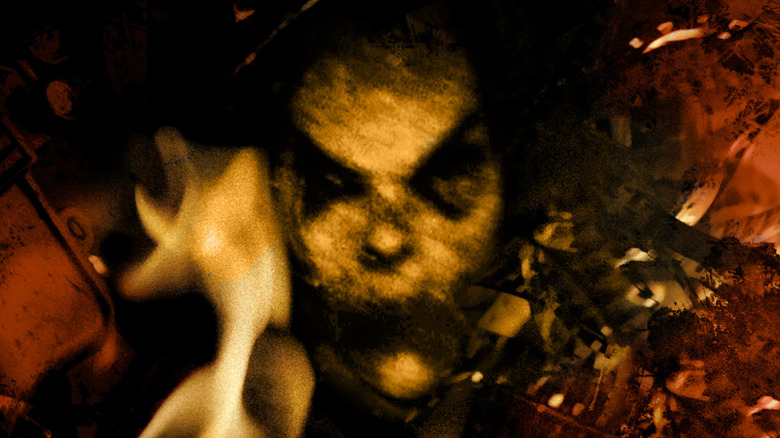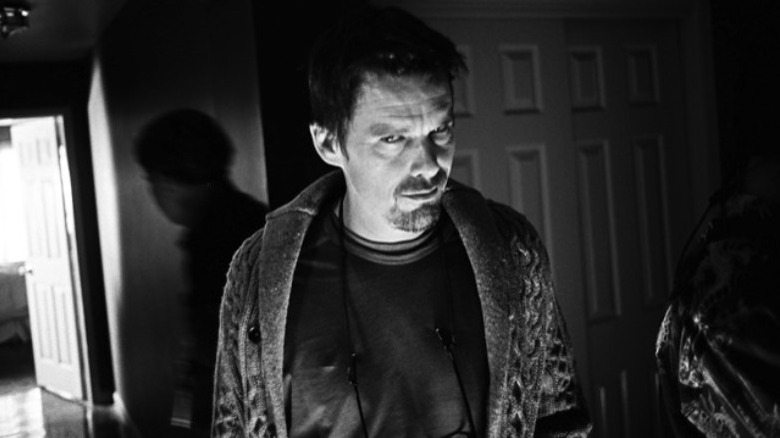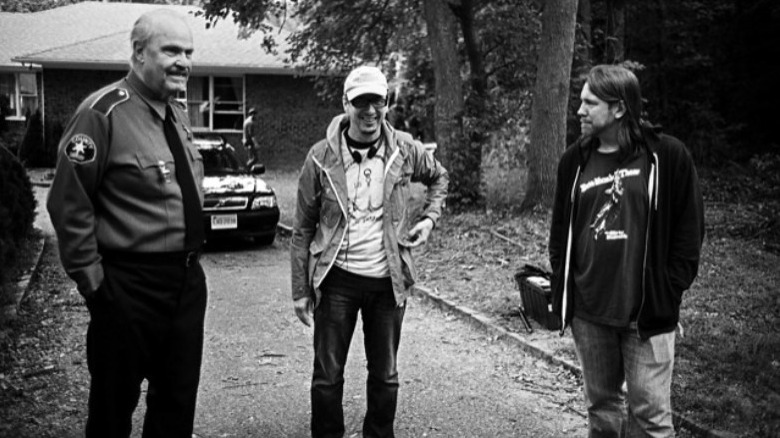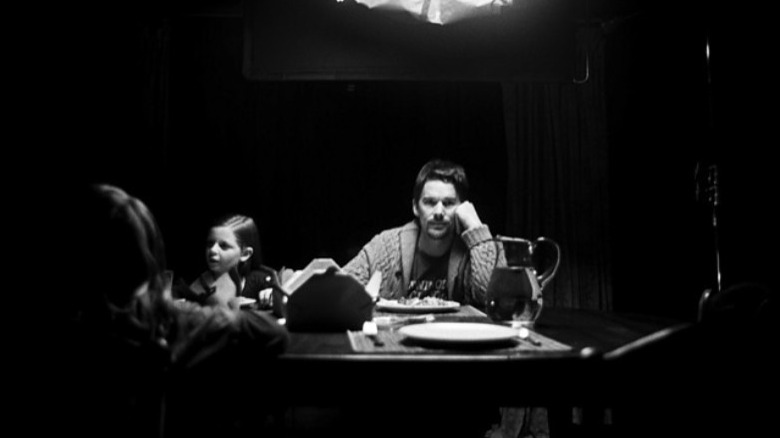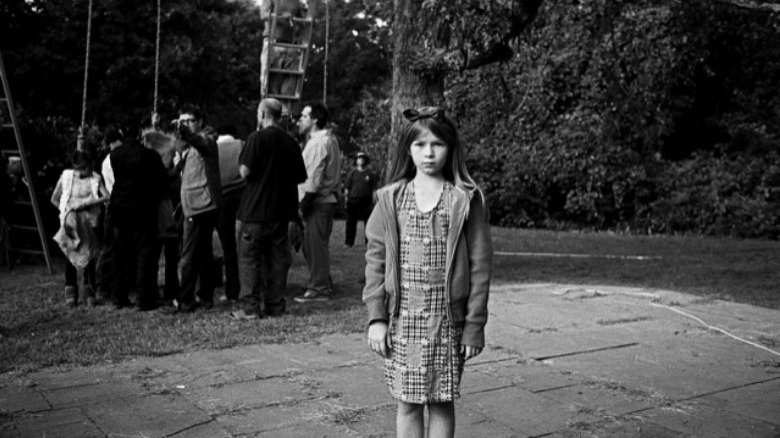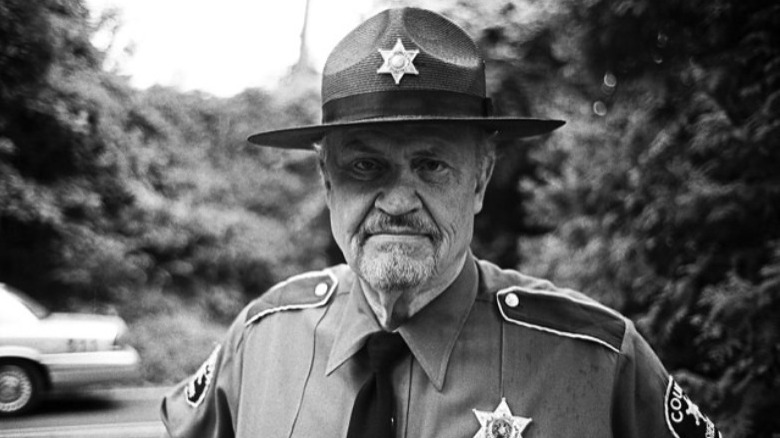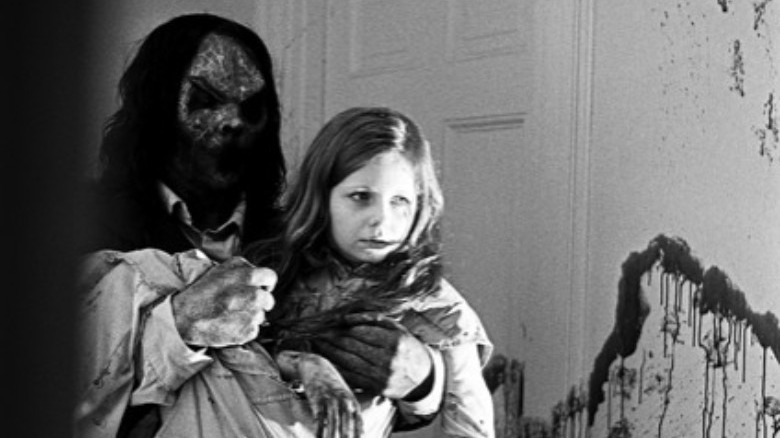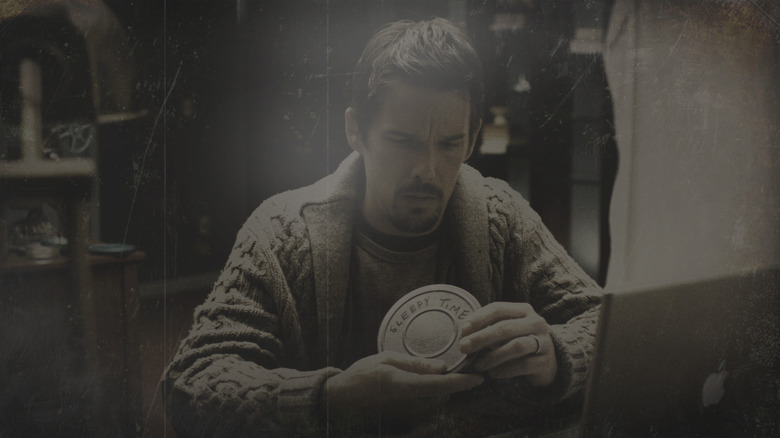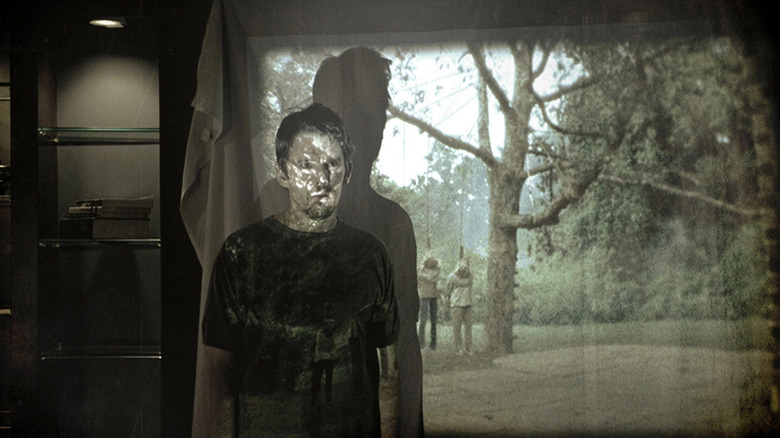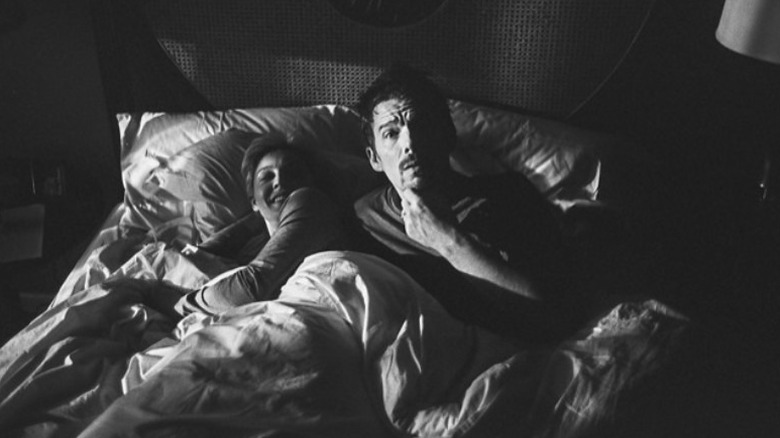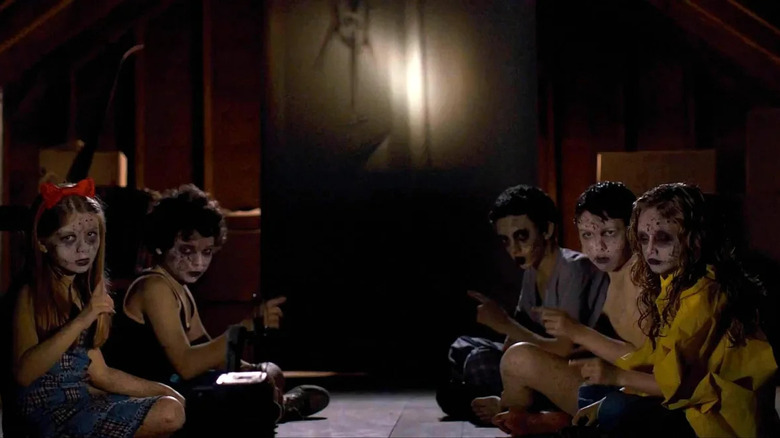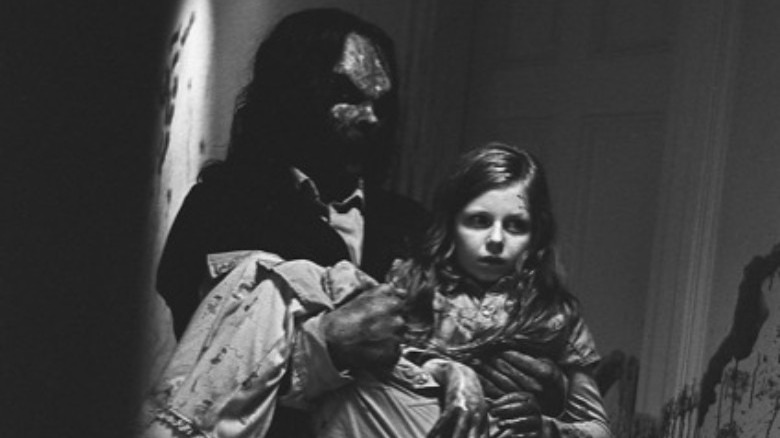Sinister At 10: An Oral History Of The Scariest Movie Ever Made
Horror is an ever-popular genre, but one where it's increasingly difficult to stand out. It takes a truly special set of circumstances for something to break through in the horror space, to endure and showcase staying power, to become something more than an easy paycheck for a movie studio. Back in 2012, one little movie managed to break through and become one of the finest horror films of the 21st century. And one that many horror fans consider among the scariest movies ever made. That movie is "Sinister."
For those who need a brief refresher, the film centers on true crime writer Ellison Oswalt (Ethan Hawke), who hasn't had a bestseller in years. So he moves his family into a house that has a murderous past — without telling his loved ones that part — and discovers a box of snuff films in the attic. What could go wrong? Everything. And on a level no one could've predicted.
Directed by Scott Derrickson, who was coming off the big budget "The Day the Earth Stood Still" remake, with a script co-written by critic-turned-screenwriter C. Robert Cargill, "Sinister" helped to establish the business model that has made Blumhouse Productions a force to be reckoned with — it was a huge hit against relatively minimal investment. But more importantly, it has gained a reputation as one of the most terrifying movies ever made. And while that's anecdotally true for many horror aficionados, science even has a say-so in that department.
Regardless of whether or not it is truly the scariest film ever made, it is a movie that has aged incredibly well. So, how is it that a director (several years before he became a household name with "Doctor Strange") crossed paths with a movie critic to craft the story of a down-on-his-luck author who moves into a house haunted by the past? I spoke with not only Derrickson and Cargill, but many of the people who worked behind the scenes to bring "Sinister" to life. Here's the tale of how this terrifying horror classic came together, 10 years after it hit theaters.
Destiny in Las Vegas
Director Scott Derrickson had been a fan of C. Robert Cargill's work as a movie critic, and they became friends. One fateful night, they both happened to be in Las Vegas and met up for drinks. It was there that Derrickson revealed he had potential financing for a low-budget horror movie and was looking for ideas. Cargill, meanwhile, had an idea that had been rattling around his head for years. At last, this was an opportunity to pitch what would become "Sinister."
Scott Derrickson (director): I had my own idea that I was developing to go do. In fact, when I met with Cargill in Vegas, when we just ran into each other in Vegas, I pitched him my idea first and his response was, "I have an idea." And I was like, "Okay, fine." Then as soon as I heard his idea, I was like, "Oh, way better idea." And that's how it all started.
C. Robert Cargill (screenwriter): The idea originated from a nightmare that came after watching "The Ring" in a theater. It goes back that far, back to 2002. It was a nightmare that stuck with me so long that I realized, about three weeks after still having the echoes of this nightmare in my head, that if it was scaring me that much, that it'd probably scare other people. I started to try to construct a story around it and it was just something I would kick around every once in a while. Finally, by about 2007, 2008, it was a solid pitch. I pitched it to a couple of friends and it would elicit really positive responses. People would get goosebumps or really be into it. But I didn't have anybody that I really knew could ever make it happen. So it was just this, "Hey, I've got this cool idea for a movie," kind of a thing.
Derrickson: This was in the wake of the glut of found footage movies. The first thing I liked was the idea of, it's a movie about the guy who finds the footage, and I loved just the originality of the Super 8 films, finding these murder films, each of them having a murder on them that ties into what this guy is there to investigate. I just thought that was an original concept that I had never heard before, felt fresh, and felt inherently scary. It wasn't a long pitch, but it was a beginning, middle, and end. I just got the whole thing. I remember saying to him when he was finished, I just said, "That's the best idea for a horror film I've ever heard." So I responded to it immediately.
Everything comes together in a hurry
Once Derrickson took to Cargill's pitch, it was all about settling on a home for the movie. Producer Jason Blum, who was just getting Blumhouse Productions going after having incredible success with "Paranormal Activity," was looking to partner with Derrickson, but producer Roy Lee was also looking to do the same. Meanwhile, Derrickson was carefully considering his next move following the financial and critical disappointment of "The Day the Earth Stood Still."
Derrickson: Jason [Blum] came to me. He had found "Paranormal Activity" and convinced Paramount to release it as it was, which was a huge hit. That made Jason a name. James Wan had made "Insidious," he saw it and said, "I want this to be a Blumhouse movie," and then paid to finish the movie and get it up to a higher quality, so that's all he had done. He came to me, and he was a big fan of [Derrickson's earlier horror film] "The Exorcism of Emily Rose." I didn't know who Jason was. He just asked me to come meet him at Paramount. I just love the guy, my closest friend in this business besides Cargill. But I remember he just said, "Look, it's very simple. I think you're a really talented filmmaker. I think 'Emily Rose' is really scary. I'll give you a $3 million budget and final cut if you'll make a scary movie for me."
Cargill: At the same time, Roy Lee was coming to you with the same model and offer. We ended up pitching to both Roy Lee and to Jason Blum in the same afternoon. They were outbidding one another, and Jason ended up winning the bidding on it. It was a combination of things, but we really liked Jason's vibe. He was working with a guy, Brian Kavanaugh-Jones at that point in time, who we're friends with to this day. They just made a great offer. I think what I remember being the clincher wasn't just the money. It was the fact that Jason said, "Scott, you can have final cut."
Derrickson: The most amazing thing about the movie is that from the first time that I heard the idea in Vegas, to selling the idea to Jason, to the movie being green-lit, to shooting the movie, posting the movie, having the movie finished, and the movie getting released, was less than a year. That never happens. The reason why I said yes to Jason immediately was, I was like, "Okay, this is it. If this is the last film I ever get to make..." I was getting offered things like "Ghost Rider 2." If I had made that movie, I probably never would've worked again. I was passing on the few things I was getting offered.
Crafting that Sinister look
"Sinister" has a very dark and distinctive look, particularly for a mainstream film. And while Derrickson was at the top of that food chain, it took an army contributing ideas to craft the film we know today.
David Brisbin (production designer): Scott and Robert Cargill, they went into it laser-focused on having a story that essentially takes place in one house. From a production designer standpoint, you can pretend that 80 sets cost the same thing as four sets, but it ain't going to work. They weren't pretending. They knew that it was to be a small-budget film. Scott's pitch to me was, "We have written this thing so that we can do a good job of the production design part of the storytelling, in a focused way. A few sets that are really good, that accommodate the entire world that needs to be seen in the story." I could read on the page that they really were honest about that, trying to have a controlled, contained world for storytelling. They kept their end of the bargain.
Chris Norr (director of photography): Digital [filmmaking] was just becoming mainstream then, and originally we thought we were going to be shooting on film, and I think Blumhouse insisted that we shoot digital. Digital is very easy to make black, but it looks very artificial where the contrast is just boosted, and we really didn't want that. I really had to deal with lighting where the blackness was really there, not something you just crunched down in post or something like that. Because the digital cameras are very sensitive, it was a lot of work on set. So there were times where I was putting black on the ceiling, putting black everywhere so there's no light going into certain parts of the room.
John El Manahi (art director): I feel like my participation in this was all the really f****** hard s***. Really going through the script and getting the visual clues because I was telling these guys when we were having these script meetings, they have a lot of photographic evidence. They had all these different things that they didn't really think out in terms of how to shoot. I was like, "Well, you have to shoot this before you shoot that, otherwise you won't have this clue beforehand." I thoroughly art directed the s*** out of that script because it was so complex in terms of how to visually tell the story. The execution of, "Okay. We've got to get a photo shoot of photographic evidence [of the crime]. You have to have these in your hands." So in order to do that, you have to set those things up.
Brisbin: We were committed to making it really scary. One of the things that resonated for me with Scott that initially started with "Exorcism of Emily Rose," is that Scott as a filmmaker really, really believes in precision. There were a couple of benchmarks that were always our guide into, how do you deliver on the scariness? One of the things that Scott said, "Look, we're getting no money to make this, so we can make it look like whatever we want it to look like. This time, our goal is the really intense, emotional scares. When we want things to be dark, they're going to be the darkest things that have ever been seen in cinema." Many, many production designers and directors look back at the paintings of Caravaggio, where there's this black, black, black, black, black in all of the shadows. But you are not really allowed to do that very often in movies because they're afraid that the blackness won't work on television and reshowing or whatever. In this case, that was off. So I could paint as dark as I wanted. Chris Norr could light as dark as he wanted. That became one of our standard tools for, how do you make the audience feel something that is just a bit over the edge?
El Manahi: The attic was a build that had to be built on a stage. We designed an elevated set that Ethan Hawke could go up from below. That whole interior of the attic was a stage build. David's plan for the attic was way more ambitious than what we could build. That was where he and I started to, I wouldn't say have a split, but I had to deliver a lot of bad news to him. I had to be like, "David, I'm sorry, you can't do that." I had to tell him he couldn't do what he wanted to do. It wasn't about me preferring another plan. It simply wasn't within the scope of the budget. It wasn't within the scope of the labor or the schedule. These guys were telling me, if you have all this with 18 foot, two by sixes, which is roofing material, which is what we had to use, it'll double how much it's going to cost. It was insane. The thing he wanted to design was massive. I was like, "Dude, I'm sorry. We can't do that." So I gave him an alternative design.
Arielle Toelke (makeup department head): It was myself and my key makeup artist who got everybody through the makeup. I mean, we did a little bit of blood and stuff, but that is disappointing because the [Bughuul, the main villain of the film], I didn't design or do the makeup or anything for that.
Matthew Tibbenham (Scott Derrickson's assistant/uncredited second unit director): I started out as Scott Derrickson's assistant, just running around, doing anything needed. Since it was a semi-low-budget movie, when I started, they didn't have an editor yet. They were like, "Oh no, we don't have an editor." But they had all those Super 8 movies that they needed edited. So he went, "Hey, can you edit?" I was like, "Yeah, sure." I started editing those, and in the end, edited four out of five Super 8 movies. Then because I did that and I had a technology background, they were kind of like, "Ethan Hawke is on his computer all the time, and we need somebody to make that. Can you make that?" I'm like, "Yeah, sure." So I made all the screen recordings in conjunction with the graphic designer and did all the graphics for it. Then finally because of that, they had I think 150 B unit shots. They're just like, "Hey, you've been making these screen recordings. Do you want to do the second unit directing?" They credited me as B cam supervisor, but it was the second unit directing which, I always say, is all the boring shots.
Trouble at the hanging tree
"Sinister" opens with a memorable (and horrifying) shot of the home's old owners being hung to death under a large tree in the yard. While the set piece truly sets the tone for the movie that follows, actually getting this scene committed to film proved to be difficult — and dangerous.
El Manahi: We used a real tree that we had cut down and brought in from Pennsylvania. We planted it into the ground with a giant welded steel stand that was like a giant Christmas tree stand. We had a time crunch because all the leaves on the tree were going to die. We had to reassemble the tree. The tree got cut down and then they numbered the branches and we reassembled all the branches on this tree. I had sculptors fill in all the gaps with this stuff called, I think it's called like paper bark or something like that. They use it in museum displays. I had scenic painters painting this tree.
Brisbin: The tree in the back, obviously we had stunt people hanging in the tree to do that gag. We designed very carefully to make sure that when the kids were getting hung, that there was foliage in front of them a little bit, so that it wasn't too intense and showing the children. But there was a problem on the first day that we were shooting, where the stunt really didn't go as safely and as well as it should have.
Derrickson: The stunt coordinator who designed the rigging for the hanging shot, and who also hired the stunt people for it, to my angry surprise, did not attend the final production meeting. Then, to my utter dismay, he didn't show up for the tech scout either — he was apparently too busy doing other things to show up and demonstrate exactly how the hanging shot would work.
El Manahi: The stunt coordinator's idea was to have a crane on the front of the house that had the actors separately, and then we would time this branch falling down and then hoist these people up in at the same time. Now, I had told them, "Under no circumstances should you get a crane." I said, "Do not get a crane. This is the worst idea. You cannot do it this way. This is going to be a disaster." So I went out on a scout, I came back to the office and I overheard, "The crane will be there on Wednesday or Thursday." I said, "Hold on a second. Crane?" They were like, "We're going to have a crane. I said, "We cannot have a crane. That's going to be a problem." I was ignored. My original design was that we would have this branch that was a huge limb that would be on something like a big hinge. It's like a bank vault hinge.
Reset for safety
The original design for the hanging sequence, however, was far more complicated and proved problematic on the day of filming. Things went awry and production shut down for several days, costing the studios thousands of dollars.
El Manahi: You have a rope that's attached to the branch and you have a rope that's attached to the actors, like a cable. When those two things go up, they separate. I was like, "How are you going to camouflage this cable?" They were like, "Nobody had an idea." I said, "I told you, you can't do it this way." What I had to do was create a quick release so the rope would be attached to the cable, and as it went out, it would separate from the cable. But that means that you had to reset it every time. It was very, very difficult. I told them this was going to be a problem. It turned into a catastrophe. Everything shut down when the actor came out of his harness. So basically what they had were these harnesses and these stirrups. These guys are in these stirrups and they're being hoisted from the back, like it's around their back. The guy came out of his stirrups, so his harness went up around his neck.
Derrickson: Thankfully, the incident didn't physically harm the stunt man, but it did shake him up badly. I was furious because the attempted stunt was clearly not safe and had not been properly tested. I've only fired two crew members in my career, and in this instance, I fired the stunt coordinator on the spot, in front of the rest of the crew. We shut down production for three days, allowing us time to hire a new stunt coordinator and arrange to do the stunt safely.
El Manahi: They couldn't get it in like... I'm talking about the whole day. We went there at 7:00 AM and now we are in two hours of overtime, 9:30 at night or something like that. They're trying to figure out how to salvage this thing. Then the guy comes out of his stirrup and it's like, "That's it. Done. We're done." So I get called into an emergency meeting and they go, "We're going to do it your way. We're going dark for six hours. We need you to redo the tree." I said, "Okay."
Derrickson: I feel that this incident was ultimately as much my responsibility and fault as the stunt coordinator's. I never should have allowed his stunt to continue, having not seen it properly tested first. The director is the last and final watchdog for safety on any set. The buck stops here. This incident taught me that, and since then I have always made sure that I see with my own eyes that every possible precaution has been taken before filming any potentially dangerous stunt.
Bughuul takes shape
While Cargill's dream had shaped the story, much still needed to be fleshed out to complete the movie. One of the things at the top of the list was the movie's monster, Bughuul, who is ultimately discovered to be behind each of the grisly murders.
Cargill: [Bughuul] was not a part of the dream. It became a vehicle for me because I was trying to figure out, why would these films exist? Who would make these films? That was the big question that haunted me for years. How do I make this work? You've got to have an answer that's better than what's in your audience's head. That's how you shock them. That's how you get them to really enjoy that mystery. I came up with this idea of it being the kids, and then why would the kids do it? I came up with this idea that I pitched to Scott as this f*****-up Willy Wonka. My original concept from the way it was formed in my head would be realized on film several years later in a movie called "The Babadook." That image was very close to what I had in my head for what Bughuul was supposed to look like.
Derrickson: I knew it needed to be something really scary and I knew that I was going to try to make it scary by how much you don't see it. That was the whole idea of putting it in a pool the first time you see it. I think that image of the first time that you see Bughuul underwater in the pool is actually really horrifying and the freeze frame on it, then the film burns up, so you don't even get to look at it for very long.
Nick King (actor who played Bughuul): People seem to really enjoy the pool scene. I was underwater for about three hours. They fed a breathing hose into the pool for me to stay underwater. Just before filming, they would take it out and we stuffed a little one gallon in my sleeve so I could take a few last breaths before the shot started. We realized early on that if I were to continue to go in and out of the pool, everything would fall off my body, so we chose just for me to stay in the water.
Cargill: The concept of Bughuul stemmed from an argument Scott and I had. I always thought Bughuul was a demon and Scott didn't want it to be a demon. As we boiled it down, he said, "What if we made it an ancient deity of some sort?" And I said, "Like a Babylonian deity." And he goes, "Yeah." And I'm like, "Well, that's rad." I literally sat down for a couple days with my research library and just started going through Babylonian myths and Babylonian stories of Babylonian gods and demons, and crafted this idea based upon how they crafted their stories so that it sounded like it was a real Babylonian deity and took it to Scott. Scott loved it and we went forward with it.
Derrickson: I did a ton of research. I was looking at all kinds of photography websites and artwork online. I think I was on Flickr. I was collecting images that I thought were interesting directions to go. I was taken with a lot of black metal face paint that was being done at the time and had been done in the '90s. Then it came down to five images that were very different directions that I really liked. I sent them to Cargill, and I said, "Which one of these do you like? Because I could take off in any of these directions." There was a photograph, it was just called "Natalie." I don't know why, but it was an image off Flickr. He's like, "I really like this Natalie image." So then as I started to work on it, the more I looked at it, I was like, "This thing's f****** scary. It's really great." The more I looked at it, the more I thought, "Well, what if it's just exactly this?" I contacted the artist on Flickr and bought it for $500. And that's Bughuul.
Brisbin: It was a strange process that we went through [to design Bughuul], which was definitely guided by Scott. He snooped around and managed to find some guy that, I don't know if he ever met him, I'd never met him, who was somewhere off at a distance. It was remote job sharing before we even all knew about that. We just pawed through many, many reference images. That guy started working on essentially the face structure, and it just went back and forth, heavily between Scott and that fellow. I would say that was born of a marriage of references that Scott and I came up with and Scott puppeteering that fellow's visual designs.
King: I spent a lot of time by myself while I had the costume on. The breathing was super restrictive on it, so it constantly made me tired.
Tibbenham: You know when Ethan is looking at the computer, he brings up an image of Bughuul, and it's just frozen? Ethan looks away, but then Bughuul turns to him and then looks back? We just didn't have it ready for him on set because they hadn't shot Bughuul yet. So that was one of the ones where it had to be green-screened on the computer. So we just made the screen recording, but that little box of video was green-screen.
The kill tapes
"Sinister" utilizes several Super 8 movies that Ethan Hawke's Ellison finds in the attic of his new home. These became known as "kill tapes" and were a crucial part of the production. But at the beginning, Cargill had only imagined the tree sequence. The others needed to be crafted as the film was coming together.
Cargill: [The Tree] was one of the images from the dream. [In] the dream I had, I went up into my attic, which I didn't have at the time, but in dream logic I did, and found this box with a projector and a bunch of Super 8 films. I spooled one of them up and it was that image. That's the image that was burned in my brain, this family being hung from a tree, and it was just terrifying. I felt like that needed to kick off the movie. It was a critical response to the cold opens of most horror films, where you have this small brief set-up of the horror we're going to experience as we get into this movie. I was like, "What if we just go right into it? What if it's just a film and it unsettles everyone, and then we go in, wondering, 'What the hell was that I just watched?'"
Derrickson: The real challenge for me was, "I can't hang a kid and get away with it." Putting the bags over their heads sort of solved that problem. They're a family just by their size. I remember I was like, "I don't know if I could hang a kid." [Cargill] goes, "You're not hanging a kid, you're hanging a family," which he was right about. Then by putting the bags on their heads, it was enough to really just say, "Here's a hanging family," as opposed to focusing on, "Oh, they're hanging a child." You don't really think that when you're seeing it because the rest of the image is overwhelming.
Cargill: We were working on the script and we knew the structure of the story and we knew the whole body of the story, because I'd already come up with it. We reached a point while writing it where Scott was just like, "All right, Cargill, bring me some kills and we'll go write a script." I literally brewed a pot of coffee and sat up in the middle of the night, just in a completely dark silent house. I got into my own head space and I wrote down the two dozen most disturbing kills I could possibly come up with, but that I knew kids could be capable of pulling off. I literally just sat up all night, one night, dreaming up these things. The next day, I sent Scott this list of two dozen kills and the first thing he said is, "What the f*** is wrong with you?" Then he goes, "These are really good." He went down and whittled through and just crossed off the list and picked his six favorites and said, "What do you think of these six?" I'm like, "Great." Originally, we had six kill films before the final film and we ended up cutting one of those during production.
Derrickson: I spent a good amount of pre-production, a couple weeks actually, all day during pre-production, doing nothing but searching the internet for the scariest music I could find that was unknown, that was relatively cheap. There's a band named Ulver who had a 25 minute track ("Silence Teaches You How to Sing"). It's a 25-minute piece with very different pieces of music, with some really disturbing s*** on it. I think three of the films drew the music from that one track. They licensed it to me for $500 or something, because it was a completely independent film. We didn't have studio backing or anything. I remember for each one of them, including the hanging, I would play the music on a loudspeaker on set when we were shooting so that people could really feel what it was meant to feel like.
Brisbin: In our process, except for the one with the hanging people in the tree, except for that, the rest of them were all shot in pre-production in L.A. We basically just went with tiny crews. I went out and found locations for those couple of places, and we kept it really trim and tight. We were going for this grainy, stolen Super 8 footage aesthetic. We shot it with that in mind. Except for the people hanging in the tree one, these were all in the bag as benchmark points to departure, that were actually meant in some ways to contrast with the world that we were trying to create in Ellison's home.
Norr: We actually had to go out and shoot Super 8, which was a little nerve-wracking because the Super 8 cameras, there's not a factory guarantee on everything. They don't make new Super 8 cameras. There's barely any equipment around. I ended up buying a Super 8 camera because of the unreliability of them, even when you rent them from a rental house. I always wanted to cover everything digitally, but they were like, "No, let's just shoot it Super 8." And we did. I kept thinking we should always cover ourselves by doing a take on a small digital camera just in case something went wrong. The last scene we shot, which was the bloody hallway, a lot of it was out of focus. At first we thought, oh my god, it's a disaster. But as we looked at it, it looked so cool. We were like, "No, this is great, actually." So it just was a mistake that ended up making it look better.
The lawnmower, the attic, and other big scares
Of all the kill tapes, the lawnmower scene may rank as the most memorable — it makes for an incredibly potent jump scare that fans still remember to this day (and which /Film ranked as the scariest movie moment of all time). But that is just one of several memorable jump scares in the film.
Derrickson: When I talked with Chris Norr, I said, "If we just got the single camera light on it and it's raining, it's going to be a really powerful image, just this lawnmower going through this lawn." I had that piece of music that I'd found that I thought was so great. Because we had water, I couldn't play a speaker outside, but I had Chris Norr wear earbuds and listen to the music while he operated the camera, because it's all him. He's the character POV. So he's acting as though he's the character. My favorite little nuance in that shot is that he had built a rig on top of the handle of the lawnmower. He just was able to seamlessly set it in this rig and then push the lawnmower. Because it was raining, because it was so wet outside, the camera slipped off to the side and then it goes off the lawnmower into the grass. He just reached out and straightened it out. It's favorite little thing in that, because it looks like the POV or the person just looking off to the side for a moment.
Cargill: Scott has a sixth sense about this. It was very interesting watching him work on set and see how he crafted those scares, because he just knows. I remember one of the first disagreements we had on set was about the box scare. It was written that the box was thrown down with all the stuff in it. Then Scott had already directed to have additional things come down. I was like, "Why are we doing that?" And he's like, "Trust me, the audience is going to hear that first bang and they're going to jump, but they're not going to expect the second one and that's going to get them. Then when the third one comes, they're not going to know what the f*** is going to happen." I'm like, "All right, I'll trust you." Then sure enough, watching it in a theater, I was like, "Holy s***, he knew."
Derrickson: I think that it's the anticipation of ... you know something really bad is going to happen, but it's like the audience can't get to the place of knowing what it's going to be. It's a lawnmower in the rain in the middle of the night. Something bad is going to happen. I think that the shock of seeing the body so quickly, the lawnmower raises up, hits the body and then we jump to Ethan's incredibly startled reaction. It just turned out to be one of those things that, certainly, of all the things I've ever worked on, that's the one that always gets the biggest reaction in terms of jump scares.
Tibbenham: One of my favorite contributions to it is the lawnmower scene, which for sure you remember. Right when you see his face, just [the loud noise]. That was me, with Scott's direction of course. But I put in that sound and just freaked Scott out.
Brisbin: Burning the garage down was quite a challenge on our little budget with the special effects. We had to cobble together a really cheap little set to do it in and get the car and whatnot. I have a stronger memory of that one because it was a lot harder work to put it together.
El Manahi: The box that the kid came out of, what I did was I had to create something where this kid could elevate himself out of this box where it would look like he came, almost suspended out of a cardboard box. So what I had to do was create a structure within this box for this kid to go in. I came up with this idea. What I did was I took apart [an ab roller] and turned it over so it was backwards. So it would follow the curve of his back. I welded it to a frame and then I made a box to his measurements that this frame could sit in. This kid would lay against this thing and have these stirrups that he could push against, then he could roll up over this cardboard and come out of this box. It was chilling. I mean, I got to tell you man, everybody was like, "Holy f***, dude. That was f****** amazing."
The crew knew this was going to be scary
"Sinister" was crafted to be incredibly scary — especially for a mainstream film — and succeeded in that regard. And it was evident to (most of) the crew before the final film hit theaters.
Norr: I had to go into this color timing session at midnight or 11:00 PM by myself. I'm in this big screening room alone and am talking to someone on the phone in L.A., just talking about coloring and I was scared s***less. I was like, "Oh my God, this is a scary film." I was actually shaking. So that's when I really realized what we had created.
Brisbin: Did I know, "Oh, this is going to be really scary?" Well, no, it was experimental, but he knew that was the goal. We were sort of just trying to marshal those tools again and again, to figure out ways, in a sense, to exaggerate, to exaggerate the spacial, emotional feeling. So maybe that helped, the exaggeration of those things.
Toelke: I thought, just because I think Ethan is so talented, that it would have success because he's such a good actor. I didn't know it was going to be the scariest movie ever made, even though I was like, "This is scary shooting it." But it's so abstract when you're making films because there's no soundtrack when you're shooting it. Things are edited and the lighting is color corrected and stuff like that. So it turns into something really scary on the cutting room floor and in the edits, even if it doesn't seem scary when you're filming it.
El Manahi: I knew this was going to be f****** awesome. When I saw the opening. When I saw what we got from the kid coming out of the box and the way that all this s*** was looking, I was like, "This is sick. This is going to be sick." I'm very happy. When I saw the screening, I was like, "Dude." I was getting choked up. I was like, "This is the most f****** amazing thing I've ever seen. I'm so psyched right now."
Tibbenham: It's hard working on a horror movie because you just watch the same footage over and over again. I remember going to the premiere, and it was like, "Oh well, this isn't scary to me. I spent months on this." Credit first to Scott Derrickson and any director who directs horror. You have to be able to sense what is scary even after the hundredth time you've seen it.
Establishing the Blumhouse model of success
"Sinister" opened on October 12, 2012, and went on to become a gigantic success for Blumhouse and Lionsgate. Against a mere $3 million budget, it grossed $82 million worldwide, helping to establish the business model that Blumhouse utilizes to this very day. That success revealed itself in various ways, at various times.
Derrickson: It went from idea to the screen in less than a year. Then it was a big hit. It's just dream scenario. We knew all along that everything was going really beautifully. It was a $3 million budget. It was a hard movie to pull off at that budget. We had crew issues because we had to shoot in New York because of Ethan, and there was very little crew available. But I'll tell you, I just think that sometimes you sort of know if the one true movie god is smiling on your movie or not. I just think, we felt like, "Oh, we're getting smiled on this one," from the beginning, all the way to the end. So it felt like a real success ride the whole time.
Cargill: It happened in waves. There was the first wave, the first feeling, which was [the SXSW Film Festival]. All of a sudden, it showed to a room full of critics, my friends, people I'm acquainted with, my colleagues. They all connected really positively to the movie. At the end of the movie, [filmmaker] Richard Linklater came up to me, a guy I had known on and off as a critic for years, and hugged me. He said, "Welcome to the club." I was elated. I'm like, "I did it. It doesn't matter how this does financially. I made a good movie." Then of course, we had a great opening weekend. We were the third-highest grossing R-rated film ever in October at the time. The movies we came behind were a monster hit in "Taken 3," I think, and the film that would go on to win Best Picture, "Argo." So it's hard to feel bad about that.
Norr: I feel as an artist when I'm restricted with budget, I become more creative. Basically, I knew going in, it was a low budget film, so I was already thinking out of the box. But it also let us take more chances that maybe if it was a bigger studio, it would probably not have the look that it did. I wasn't really expecting much, I'm just a professional, so I just move forward from project to project. I didn't expect it to be as popular as it was and I'm very proud of the project. Sometimes you make some really great cinema, but it doesn't get appreciated because the movie's not successful. I'm thankful, but I was surprised for sure.
King: Going into it, I was unclear of what the outcome of the film would be. I actually remember about 30 of my friends and I went and saw the movie opening night. I believe everyone enjoyed it and it's a memory I will remember for the rest of my life, even though the movie theater made me buy my own ticket [laughs].
Brisbin: It turned out, quite honestly, to be, of all of the projects that are designed through decades now, the return on investment for the studio, not for me, but for the studio, was the highest ratio of anything I've ever had anything to do with. I can tell you from the inside that there was more honesty to this than in most variations of Hollywood accounting I've ever seen.
The lasting legacy of Sinister
Those I spoke with about making "Sinister" all took something away from the production. Regardless of what they've done since, the film ranks as a special experience in each of their respective careers.
Tibbenham: It made me very proud, and I was glad to be a part of it. Blumhouse did have "Paranormal Activity" and "Insidious" by then, so [we] definitely had a suspicion that it was a hit. Just having watched so many edits of it, even though it wasn't scary to me, it was still a very enjoyable movie. So when it came out, I wasn't too surprised, but just very proud and happy.
Norr: It's something, out of all my stuff, I'm still extremely proud of. I take every project as it is and I don't really compare one to the other. Everything's a new adventure, a new visual language. I've brought what I did on "Sinister" a little bit to other projects where I could.
El Manahi: Well, it was a smash. It was a smash success. I'm really, really proud of that movie. I've done a few horror movies since then. I don't know if you've looked up my IMDb, but I've done a bunch of stuff and I could tell you loads of stories about things. But this one was like on another level.
Derrickson: When Jason came to me and said, "I'll give you a $3 million budget and final cut," I was like, "Okay, great. Well, if this is the last movie I get to make, I'm going to make a movie that I want to see." Because I felt like I had died on somebody else's sword on "Day the Earth Stood Still." I found myself at the end of somebody else's movie. I was like, "I'm going to make the movie that I want to make." That's exactly what we did. It was a movie that was totally uncompromising. There was pressure at times to change things. The ending is pretty bleak, but it was, I think, a very pure experience for both of us, because it was Cargill's entrance into the production of something that he had written. For me, it was as pure of a filmmaking experience as a person can have, because I wasn't thinking about the success of the movie at all. I was thinking about making it good, making it really scary, making it the horror film that I wish I could go to a theater and see. I've tried to operate that way since — just make every movie like it's your last one. Because one day, it will be.
Cargill: The fact that, years later, there's a conversation about our film as to whether it's the scariest horror movie ever made, that's the dream as a horror filmmaker. That was the moment that I was like, "Holy s***, we made it." We made something that's going to last, that's going to endure, that horror fans are going to share for a while.
